- Science Castle Research Fund
- Announcements for middle and high school students
- Information for Teachers
- Digest of Oral Presentations
- Research Tips
Giving Visible Form to Invisible Phenomena! Elucidating Heart Synchronization [Science Castle 2023 Kanto Digest].
2024.05.31
We will provide a digest of the Science Castle, an academic conference for junior and senior high school students where the next generation of researchers are active, as well as the excitement of the event. In this issue, we report on the presentation by Nana Saito, a second-year student at Yaitahigashi High School in Tochigi Prefecture, who received the Mitsui Chemicals Award for her oral presentation at the Science Castle 2023 Kanto Conference!
Affiliation and grade are as of the time of the announcement.
I want to express invisible phenomena in a visible form.
Hello everyone. My name is Nana Saito from Yaitahigashi High School in Tochigi Prefecture, Japan. My research theme is "Mathematical and Physical Analysis of Nonlinear Phenomena. I like to pursue the "why" in the world and science that can represent invisible phenomena with letters and mathematical formulas. I used to encounter "Synchronous Phenomena," which is a mathematical expression of complex phenomena, in an IPU course at Utsunomiya University. Since then, I have come to think that it would be very interesting to express invisible phenomena in visible form.
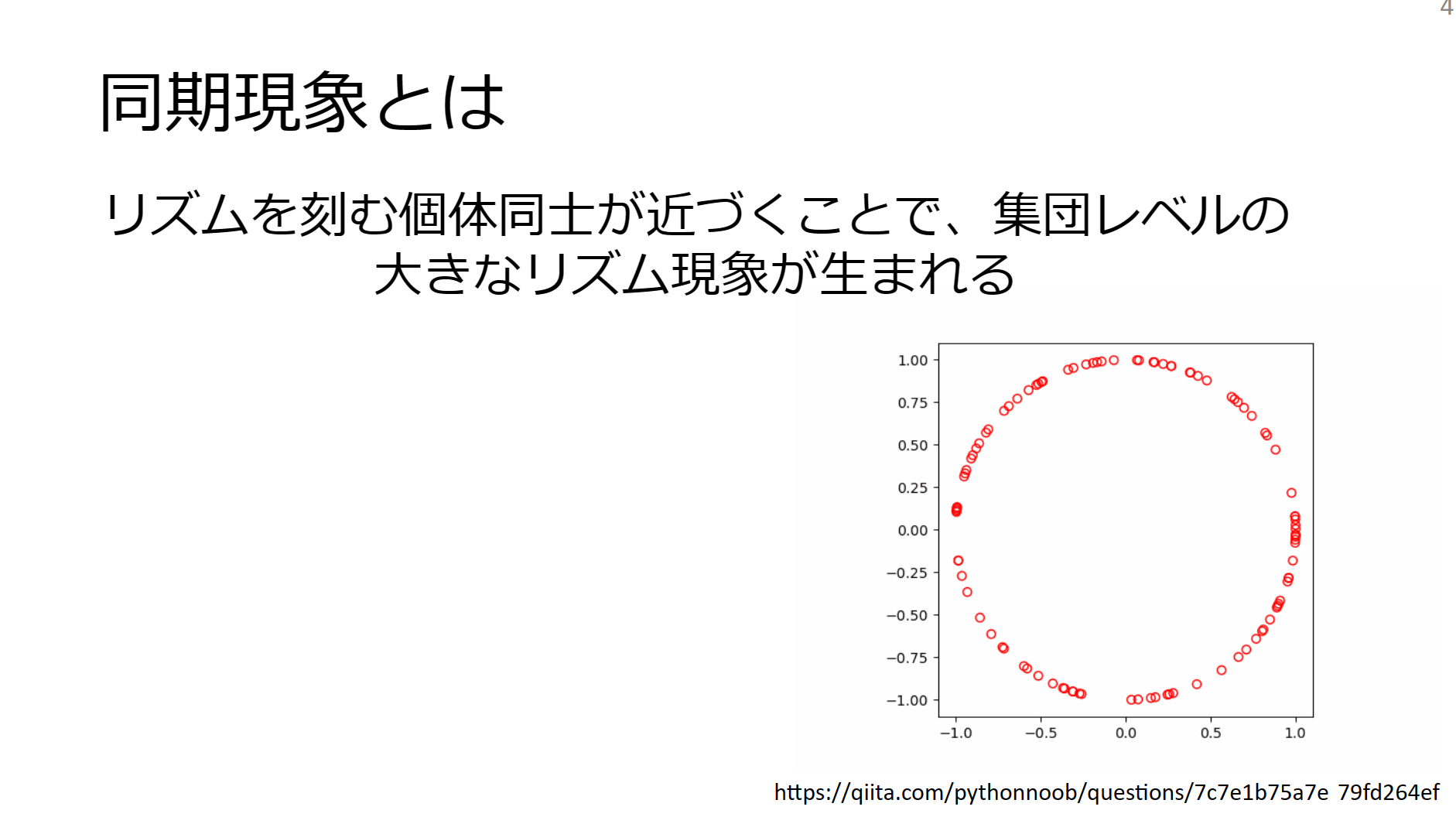
A synchronous phenomenon is "the occurrence of a large group-level rhythm as rhythmic individuals move closer to each other. Synchronization phenomena around us include firefly light, candlelight, a clock tower, a beating heart, and a chorus of frogs. Of these, I was particularly fascinated by the synchronization occurring in my own body, the heart, and decided to study cardiac synchronization.
Elucidating Mechanisms in Heart Beating
The heart pulsates by synchronization of myocardial cells. The connecting ducts between cells are thought to play an important role in this. The connecting ducts of cardiomyocytes are like the crosswalks in a shopping mall.
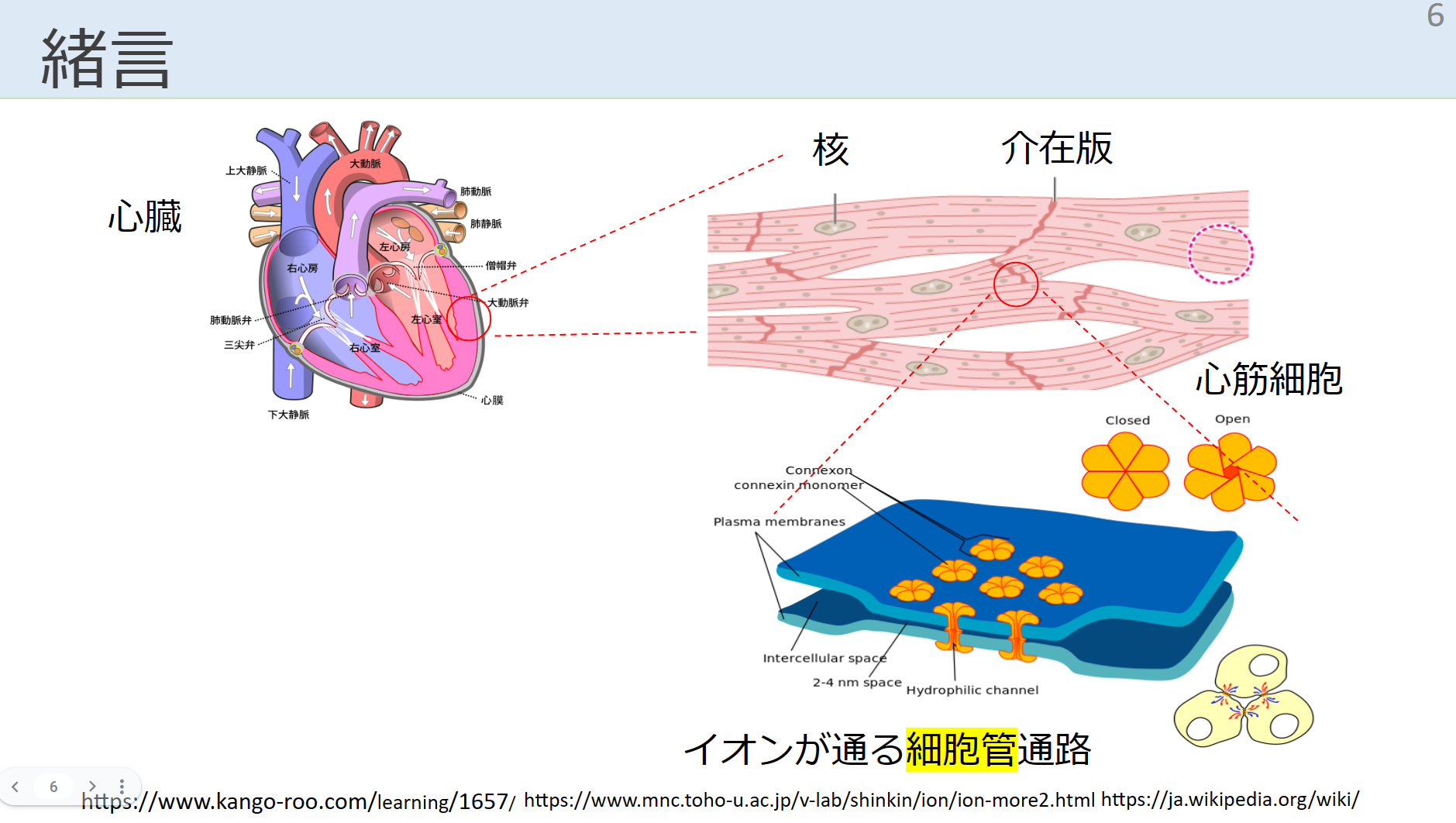 |
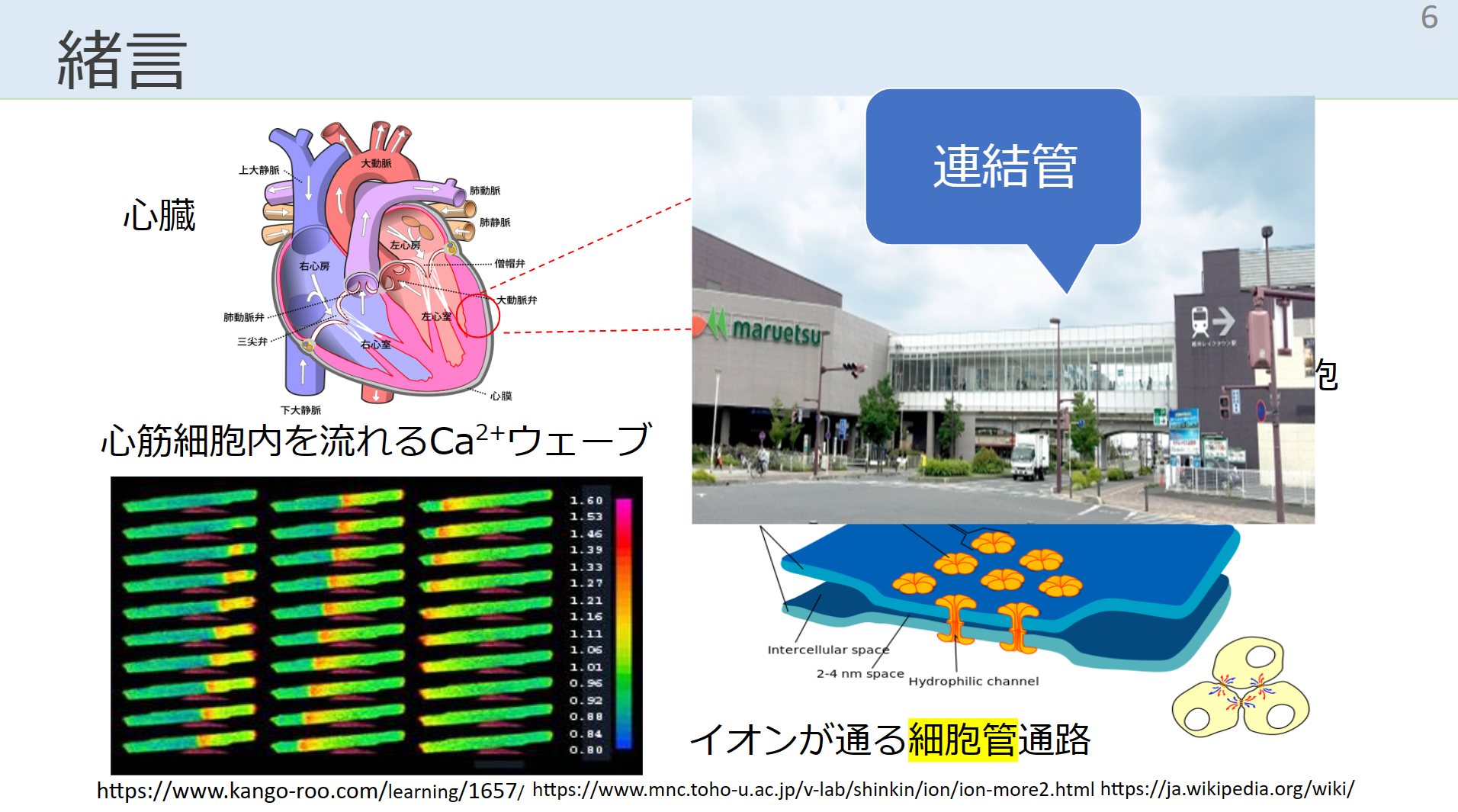 |
It is believed that the distribution of calcium ions, a signaling molecule, is observed between the connections of these cardiomyocytes, which allows the heart to pressurize. Therefore, I took on the challenge of visualizing the synchronization phenomenon by replacing the cardiomyocytes with two reaction chambers. There have been many simple approaches to the synchronization phenomenon in the field of mathematical physics, but most of them have been tested using thin connecting tubes. This is because the behavior of a thick coupling tube is unique because the numerator is a single reaction element. Therefore, we thought that if the oscillation period of the reactions at both ends of the thick connecting tube coincided with each other, the phase equation could be visualized, and our research was aimed at studying the phase change of the BZ reaction in the connecting tube. As a hypothesis, we also thought that in a complex structure inside the connecting tube, it might be coupled with other oscillators through the phase difference of the connecting tube.

Experimental Methods. The BZ reaction was represented by 5 reagents for the reaction and analyzed as shown in the image.
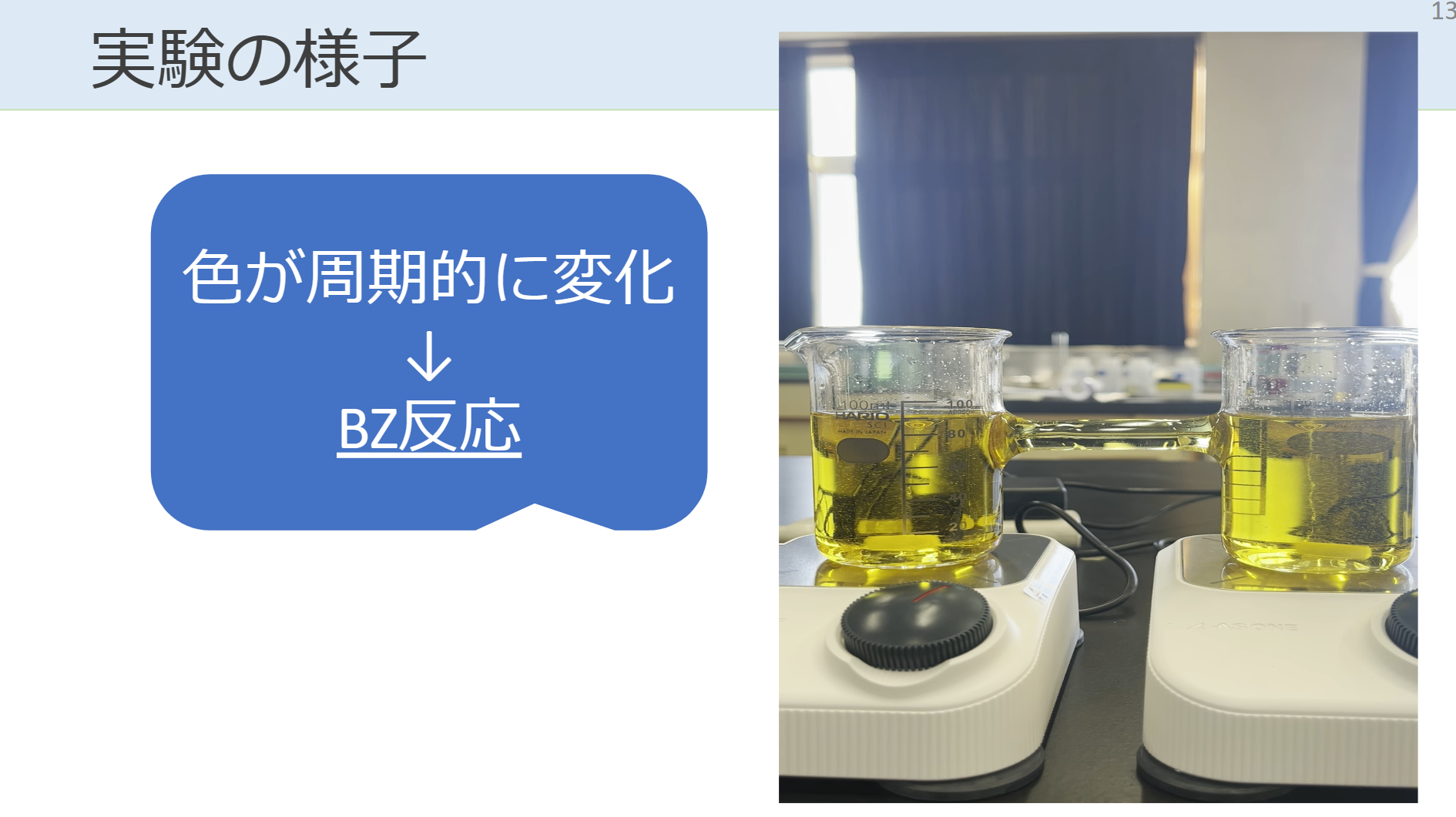
Here is a view of the experiment. In the left and right reaction layers, the color of the region is changing from darker to lighter. This is called the BZ reaction.
Next are the results and discussion. The time variation of luminance over a period of about 10 seconds is shown. In part 2, the velocities at both ends were constant, but we could see that the phase feed was adjusting in part 2. In parts 0 and 1, the phases are aligned at the first peak, but at the second peak, the phases are aligned at 3, 4, and 5.
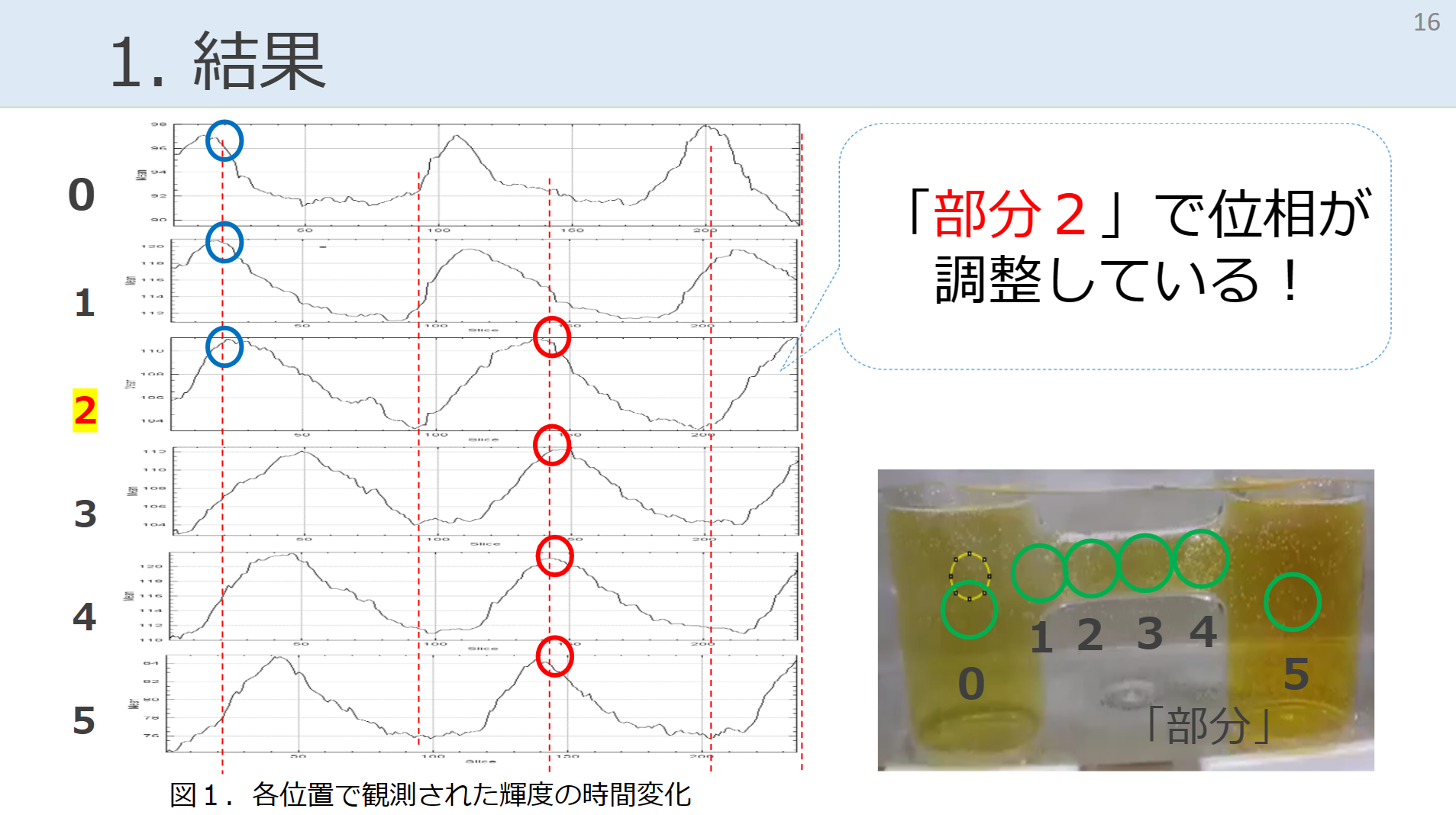
Next, we compared the speed of phase change: fixing the time of the S-curve, we find that the phase is larger and the speed of change is faster in part 2. Extracting the time variation of the phase, we also found that the transfer change speed is fast in parts 2 and 3.
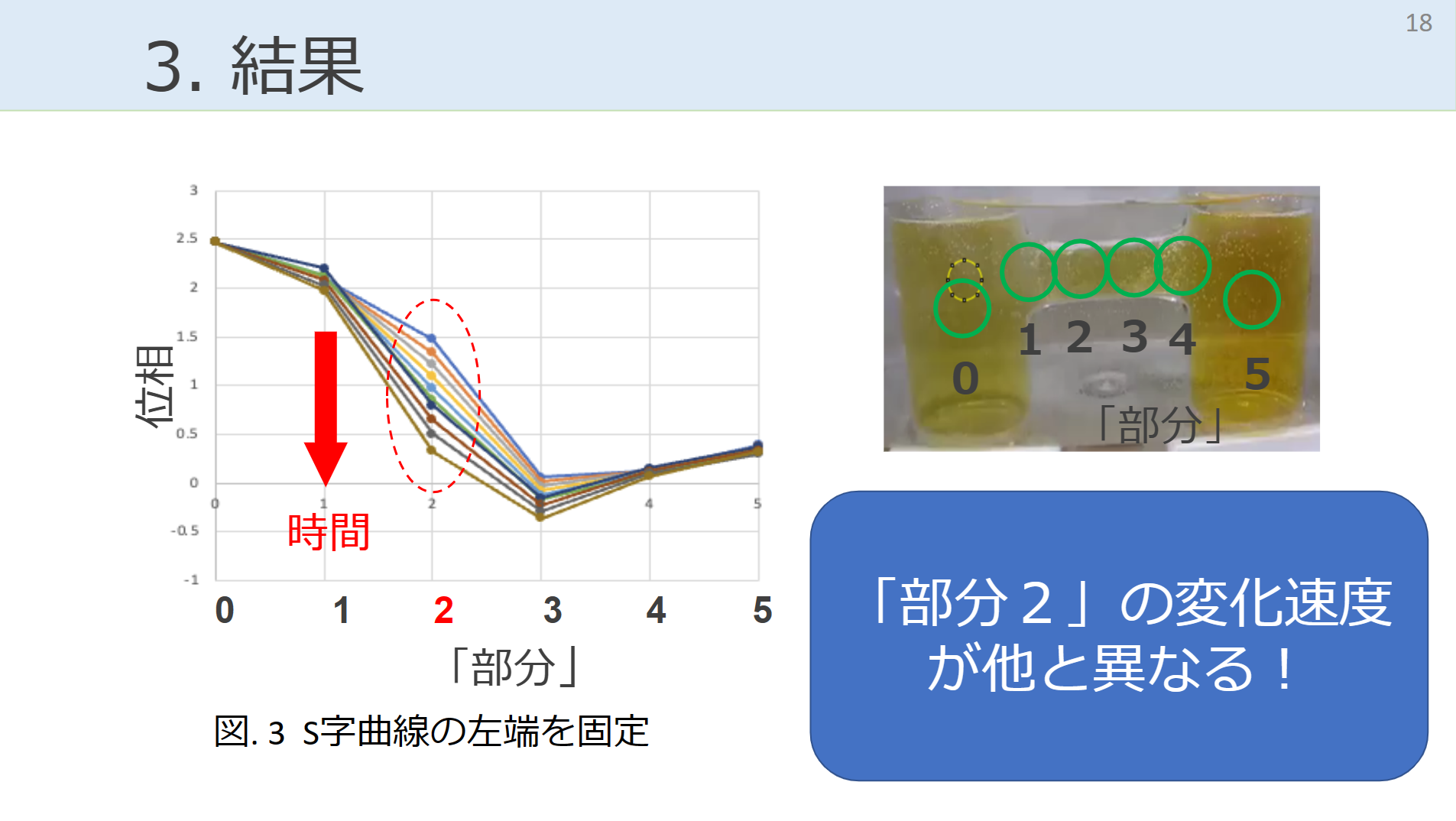
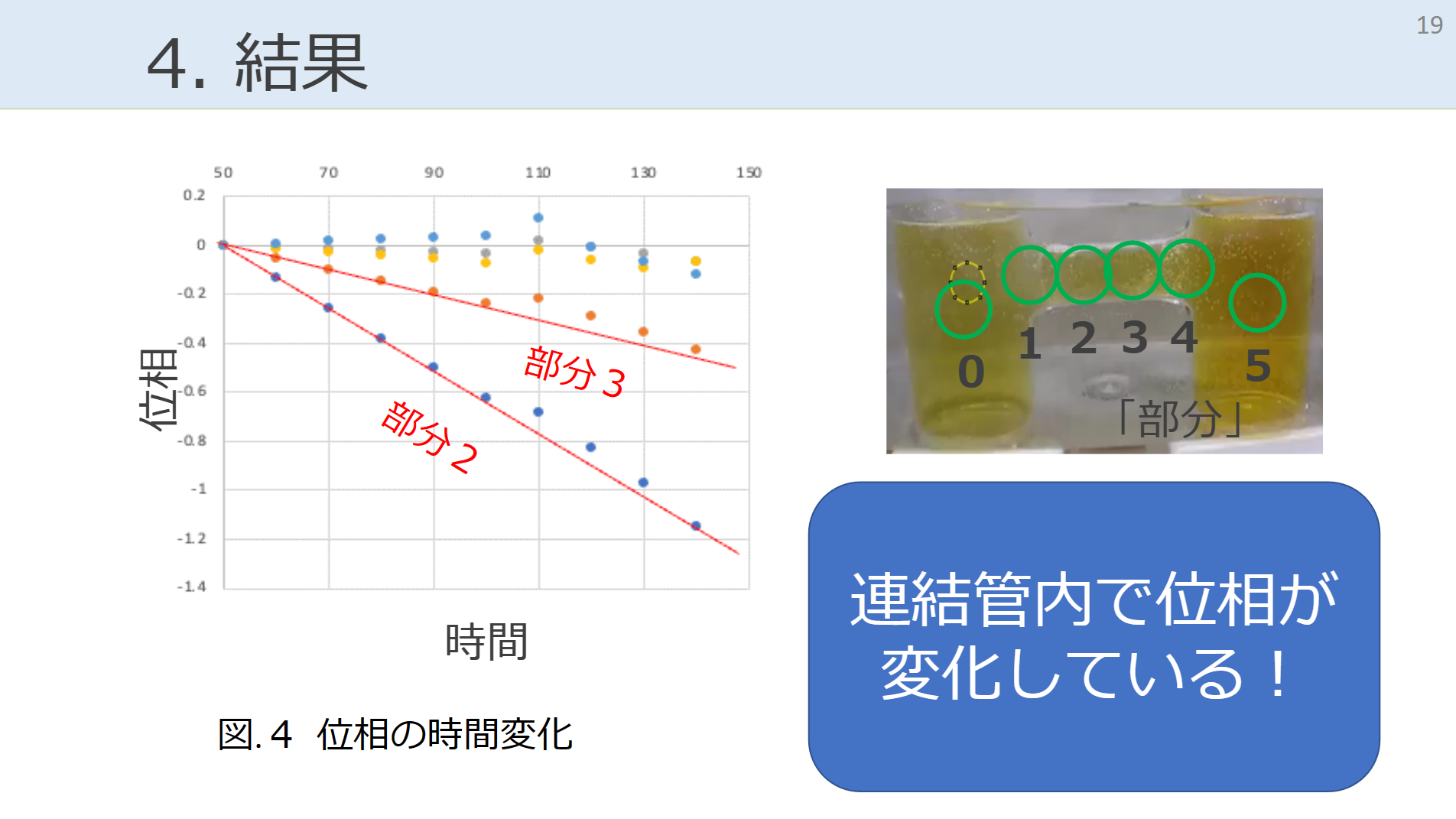
Saito Model" aims to visualize cardiomyocytes
My research revealed that the phase is adjusted in the inner part of this connecting tube. I thought that the Kuramoto model could be used to represent the reaction equation using this phase difference. The Kuramoto model is a "mathematical model that describes a group of nonlinearities. It is expected to have a wide range of scientific applications. In this study, I conducted a simple simulation to see if the Kuramoto model could be used to reproduce a situation in which "only the middle part of the connecting tube changes without synchronization. I considered three parts interacting with each other. The red point is part 1, the blue point is part 2, and the green point is part 3. When the green point part 3 and the red point part 1 are synchronized, the middle part 2 is also synchronized.
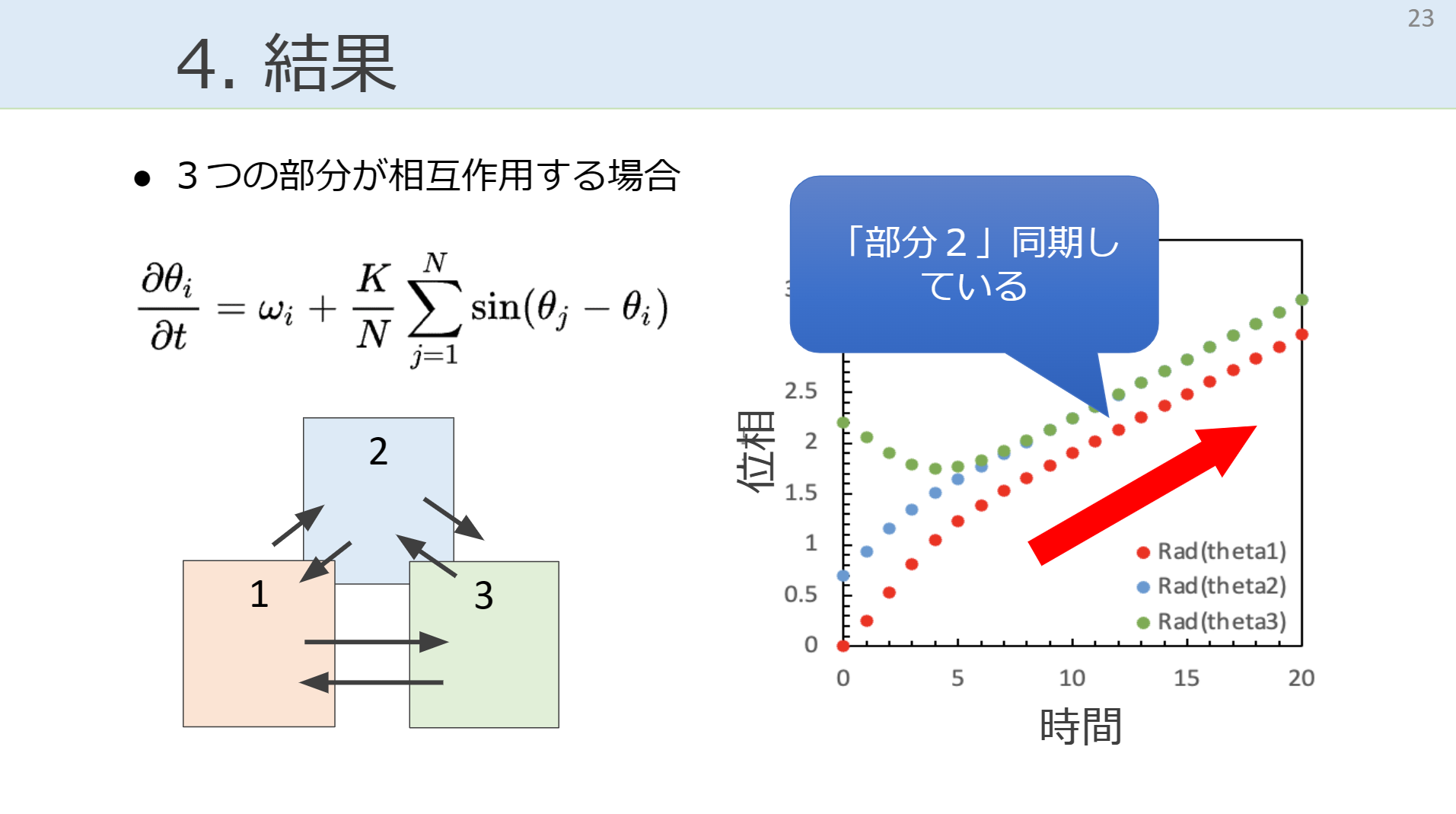
Next, we performed the calculation assuming that there is no interaction between part 1 and part 3. Again, we see that the blue point, part 2, is synchronized. So far we have not been able to reproduce the situation where both ends are synchronized, but only the middle changes without synchronization.
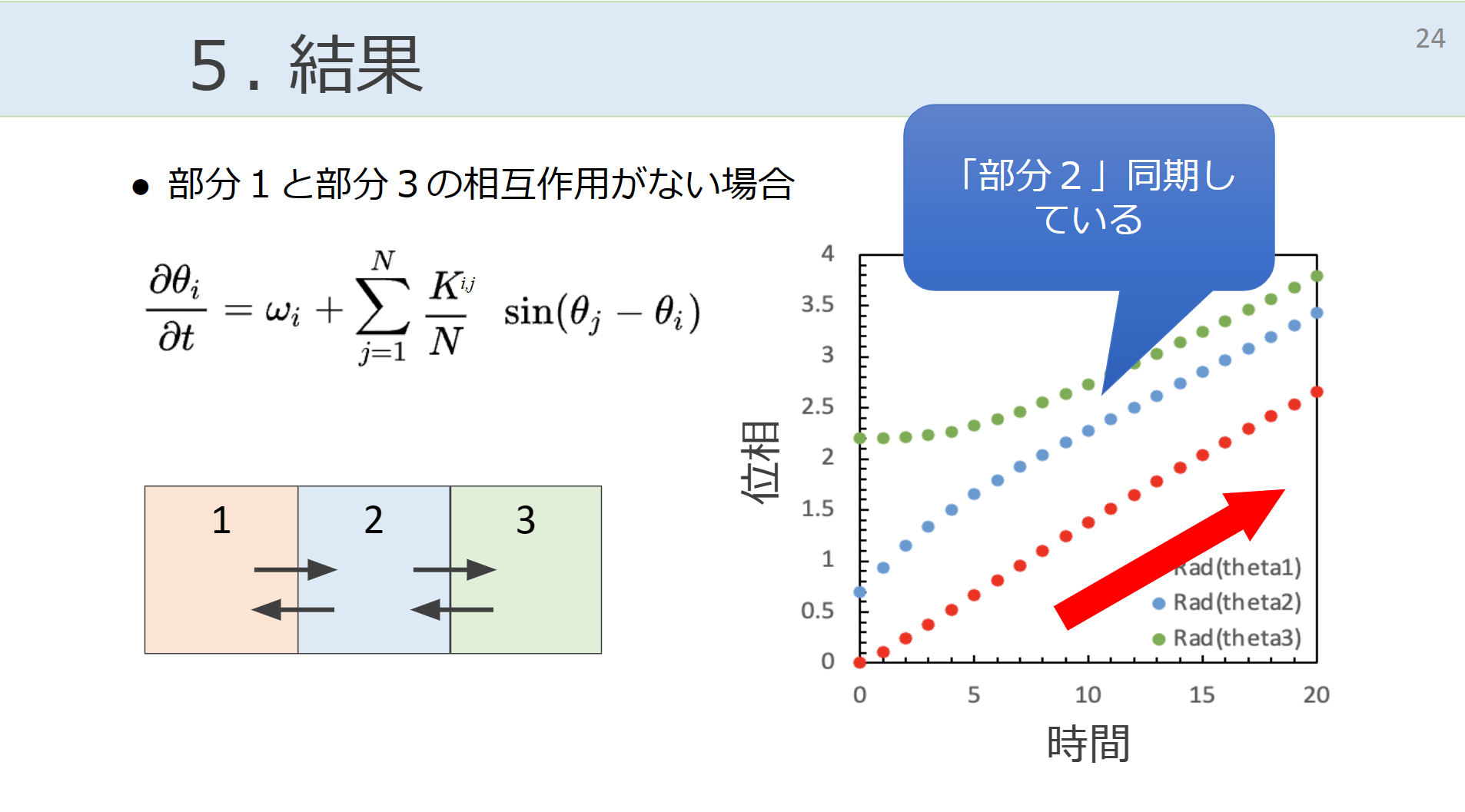
We thought that the cause might be that "there is a non-negligible amount of material flow in the connecting pipe, which cannot be represented by the Kuramoto model alone. In the future, I would like to perform simulations by adding convection equations to the Kuramoto model. In the future, I would like to visualize the structure of cardiomyocytes as the [Saito model].
We would like to contribute to the treatment of myocardial infarction by elucidating the synchronization phenomenon.
Looking ahead, I would like to continue to analyze how the reaction wave is progressing in the connecting tube connecting the two reaction chambers. I think it would be wonderful if this research leads to the treatment of myocardial infarction. If the reaction wave does not progress well in the connecting tube that connects the cardiomyocytes, the conditions for synchronization of the cardiomyocytes will be disrupted, leading to myocardial infarction. In the future, we would like to conduct experiments by replacing cardiomyocytes with two reaction vessels to visualize the inside of the connecting tube of cardiomyocytes during myocardial infarction and contribute to the treatment of myocardial infarction.
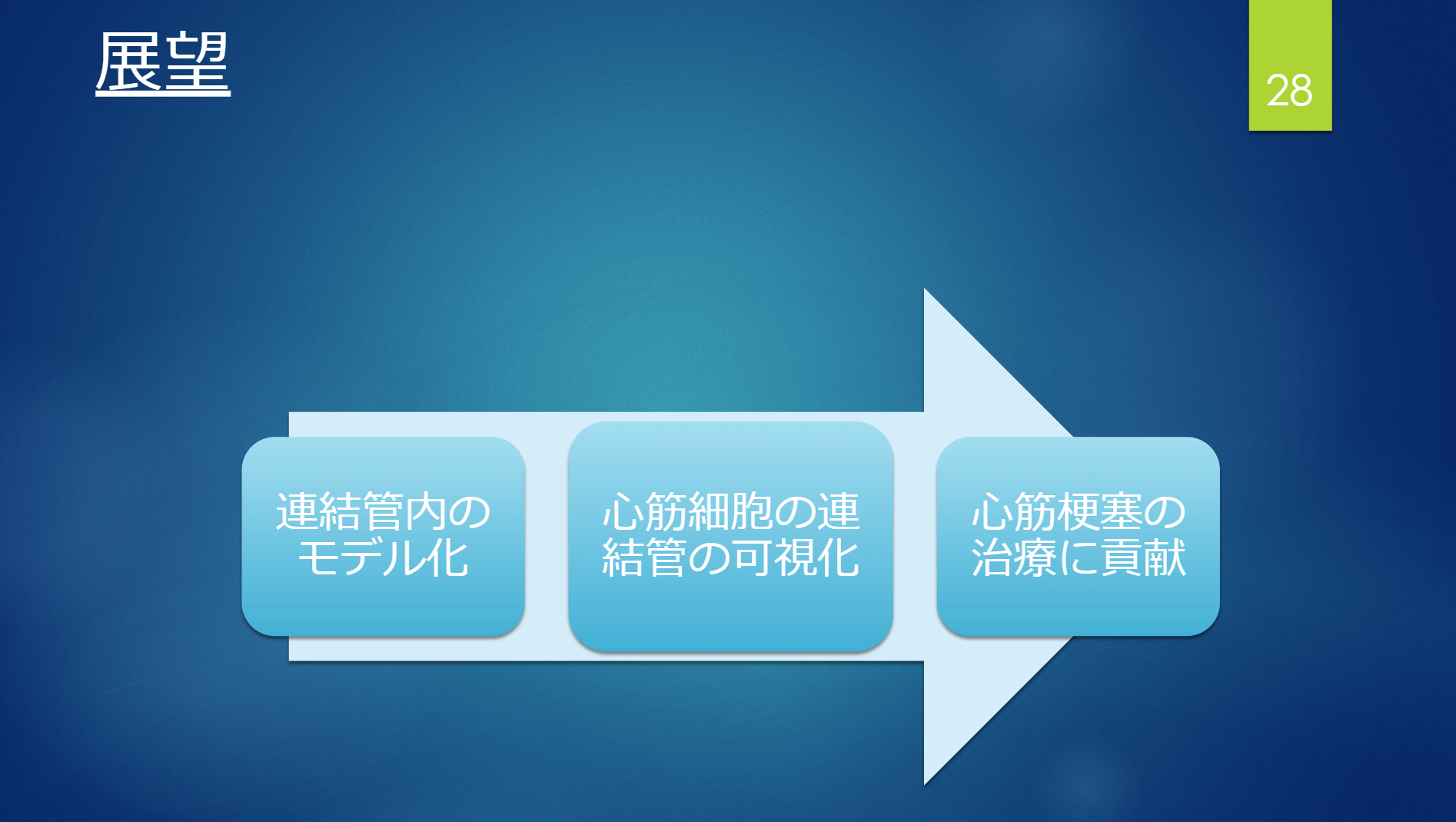
question and answer session
the heavens (taking) best care(Mitsui Chemicals, Inc.):
Thank you for your very interesting presentation. I too specialize in chemical engineering, basically reactions.equationI was very impressed with the BZ reaction and the fact that you really visualized it with a thick tube. Did you make these tubes yourself?(at sentence-end, falling tone) indicates a confident conclusionis it?
Nana Saito:
This time, the connecting tube was made by special order.
the heavens (taking) best care(Mitsui Chemicals, Inc.):
Then, as difficult as it may be, the thickness and length of the tube.Change.If you go, you'll get an empirical formula.I can get out of it.I think that this is a good idea. In doing so, we can really make Saito's model(at sentence-end, falling tone) indicates a confident conclusionI am very excited about this.
Nana Saito:
Thank you very much.
Naoki Morishita (Nippon Ham Co., Ltd.):
Ultimately, they wanted to visualize the synchronization phenomenon of cardiomyocytes, and I think they are currently making thicker tubes for that purpose, but I was not sure where this model could really reproduce cardiomyocytes. As Mr. Uehara mentioned earlier, I thought that changing the thickness of the tubes might reveal various things. Please consider it.
Nana Saito:
Thank you very much.
Tetsushi Nishiyama (Liverness Corporation):
Thank you for the excellent presentation. One thing that caught my attention when I saw the presentation was the synchronization adjustment in part 2. I wondered why the second part was slightly to the left and not the third.
Nana Saito:
Thank you for your question. I expect that the phase was adjusted in part 2, where the phase was observed a little earlier, because I started the stirring in the left reaction layer and then started in the right reaction layer. Next, when I started stirring in the right reaction layer and started in the left reaction layer, I saw that the phase was adjusted from closer to part 3, so I suspect that the reaction tank where the stirring takes place is having an effect.
(*Honorifics omitted)
